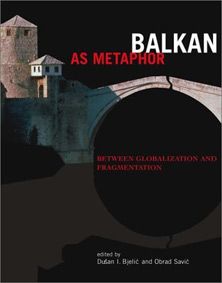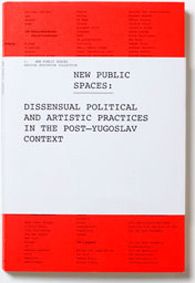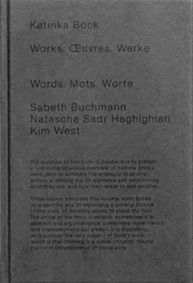The Clandestine Histories of the OHO Group
The book 'The Clandenstine Histories of the OHO Group' holds a new light to the problem of the character of neo-avant-garde excess and the experimental work of the OHO Group – leading neo-avantgard group in the region - in the second half of the 1960s.

The book focuses on the practices, works, and instances with which – under the conditions of socialistic modernism – the OHO Group problematised, provoked, and destroyed the socialistic order of the vision of the autonomy of art.
The book exposes the activity of the OHO Group (1966-1971) and of the movement OHO-Catalogue (1966-1970) in the context of Slovene national culture, Yugoslavian socialistic culture and international youth culture of the late 1960s and early 1970s, particularly in relation to the following paradigms:
1.'Transgression' – in terms of the breach in relation to Catholic traditions and morals as well as to the socialist work ethic that the young artists carried out at that time;
2.'Sexuality' – in style with the Zeitgeist and in connection with the worldwide sexual revolution on one side and the use of sexuality as a critical and subversive instrument rising up against the opportunism and hypocrisy of real-socialism on the other.
3.'Politics' – the provoking and mixing of practices from contexts – which were allowed by politics – to the context of a serious understanding and practice of the revolution and emancipation from 'the everyday grey' of real-socialism. At the end of the 1960s, the writer of new arts and activist, Bora Ćosić, wrote about the OHO Group: 'I call it a movement. The group looks like something static, something rooted, something buttoned up. The Group still holds firm, just like a machine-gun bunker; that a movement can operate as an illegal organisation, equipped with medicine, good will, and a feeling of freedom.'
The OHO Group was created in an atmosphere of new artistic practices: from the aesthetic, philosophical and social movements of reism, structuralism, poststructuralism and Tel Quel across to the New Left, hippy culture all the way to arte povere, body art, experimental film, conceptualism, processualism, post-object arts and ludism.
Miško Šuvaković is an internationally recognised theoretician, lecturer, writer, and curator, as well as one of the greatest connoisseurs of contemporary arts in the region. He is an honorary member of the Slovenian Society of Aesthetics. He achieved his doctorate at the Faculty of Fine Arts at the University of Arts in Belgrade and is a professor at the Faculty of Music Arts in Belgrade. Miško Šuvaković teaches theory of art in the interdisciplinary postgraduate study programme of the University of Arts in Belgrade. He is the author of numerous works on the field of contemporary visual arts, among them: Impossible Histories – Historical Avant-gardes, Neo-avant-gardes and Post-avant-gardes in Yugoslavia, 1918-1991 (The MIT Press, Cambridge, MA, 2003), Politics of Painting (Politike slikarstva) (Koper, 2004), Pojmovnik suvremene umjetnosti (Zagreb and Ghent, 2005), Conceptual Art (Konceptualna umetnost) (Novi Sad, 2007), etc.
Balkan as Metaphor
Between Globalization and Fragmentation Edited by Dušan I. Bjelic and Obrad Savic
Balkan. Somewhere between a tragedy and a myth, a place and a condition, the term is perhaps best understood as a metaphor. It has been used and abused in academia by proponents of opposing political views. Multiculturalism has appropriated it, as have postmodernism and postcommunism. It is used pejoratively to refer to excessive specialization and nostalgically to refer to Europe's lost people—its wild warriors and passionate geniuses. This book explores the idea of the Balkan as metaphor and the meaning of Balkan identity in the context of contemporary culture. Focusing on Balkanism both as a body of knowledge and as the critical study of that discourse, this book does for the Balkans what Edward Said's Orientalism did for "the Orient."
The sixteen authors, most of whom were born and educated in the Balkans, apply the Western academic tools of postmodernism, poststructuralism, deconstruction, psychoanalysis, and critical multiculturalism to topics as varied as the rhetoric of Balkanization, the war in Kosovo, Western demonization and erotization of the Serbs, Balkan film, human rights legislation, Byzantinism, the vampire as an image of Balkan violence, envy of the political and moral capital of victimhood, the tendency of the Balkan psyche toward depression, Serbian machismo and homosexuality, and wartime rape. The book both lays the groundwork for a new field of study and serves as an act of resistance against the many forms of representation that break the Balkans into fragments such as NATO army bases and digital maps in order to wire them into the global market.
'The Clandenstine Histories of the OHO Group' € 29,50.-
Mona Vatamanu Florin Tudor
How do you present the work of artists who not only paint paintings but are also the makers of films, installations and performances? Artists, moreover, who come from Romania and here, in the West, confront us with the charged nature of the history of the former Eastern bloc, Communism, uprisings and revolutions. Vätämanu and Tudor's work is political and documentary, but it is also poetic and aesthetic. It makes reference to activism and protest in East and West, as well as to specific places such as Ceauşescu's Bucharest.
Kummer and Herrman elected to make a fairly small and hermetic book with compactly designed pages for the essays, which are of a highly theoretical nature. The illustrations of works are placed in a variety of sizes on the pages between the essays and can be read as series, though they are fragments of a greater whole, remnants of events and demonstrations fixed in time. The panel found this book very beautifully made and handsomely bound.
Man Ray
La Photographie n´est pas l´art, 12 Photographies avant-propos de André Breton
Faksimilierte Neuausgabe der legendären Publikation von 1937
Autoren: Herbert Molderings
Sprache: Deutsch / Englisch / Französisch
Format: 24 x 16,5 cm
New public spaces: dissensual political and aesthetical practices in the post-Yugoslav context
is a reader edited by a Radical Education Collective from Ljubljana (Gal Kirn, Gasper Kralj and Bojana Piskur). It drew its inspiration from encounters and conversations with activists, artists, critical thinkers, curators, militant researchers and writers from Belgrade, Helsinki, Istanbul, Ljubljana, London, Pristina and Prizren in April and May 2008 at the social centre ROG and the AKC Metelkova mesto in Ljubljana. Those encounters challenged not only the distinction between ‘serious’ discussions and ‘informal’ debates – that instantly reproduce linear time and hierarchical space – but also our mutual ability to listen, talk and share experiences (instead of consume information). Contributions were subsequently elaborated into the reader, which consists of two parts. In the first part, engaged collectives reflect on the organisation of different political issues: from anti-capitalist and student struggles, to immigrant workers and the re-appropriation of public spaces in the region. The second part focuses on specific art collectives from Kosovo and Ljubljana, which are occupied with the question of space: why was space so important when rethinking the relation between art and politics, and also what can one do with the space? Here, a set of political practices enabled art collective to undermine the presupposed liberal border between public and private. The reader concludes with a presentation of some art projects that intervened and articulated spatial and visual transformations in the post-Yugoslav context.
'Left-Handed Blows: Writing On Sound 1993 - 2009'
Bruce Russell is like, the granddaddy of new music. If you think the dings and tings you're hearing in low lit performance spaces are out of this world, imagine what he's been up to for the past few decades. From the Dead C to Handful of Dust, he's made his mark by refining (and redefining) sound art from his hometown in Dunedin.
To take a leaf from Walter Benjamin's book: "Strength lies in improvisation. All the decisive blows are struck left-handed." It's a poetic introduction to the massive collection of essays, catalogues and liner notes in Left-Handed Blows. From his entirely improvised gigs, to a critical review of sound's place in culture, the book gives a great picture of how much Russell has done for sound art.
In a genre that's constantly evolving, this is a wedge of time that's been perfectly captured, edited, printed and bound (beautifully, I might add) by fellow New Zealanders and art publishers Clouds. So the next time you're blown away by the boutique sounds being played around town, you'll know to thank Russell and his left-handed blows.
Katinka Bock - Works
Oeuvre. Werke. Words. Mots. Worte 2010
Hrsg. Thomas Boutoux. Verlag: Verlag für moderne Kunst, Nürnberg; Paraguay Press, Paris 2010. Texte: Sabeth Buchmann, Natasha Sadr Haghighian, Kim West. Deutsch/Englisch/Französisch.
152 Seiten, zahlreiche Abbildungen.
In ihrer ersten institutionellen Einzelausstellung in Deutschland zeigt Katinka Bock (*1976 in Frankfurt, lebt in Paris und Berlin) Skulpturen, Filme und Installationen, die einen räumlichen Gesamtparcours kreieren. Ihren reduzierten Arbeiten ist zueigen, dass sie Spuren – sowohl historische, aber auch verborgene – verfolgen, die dann im Bezug zum Raum ein Spannungsfeld und dem Besucher ungeahnte Dimensionen desselbigen eröffnen.
Die Wechselwirkung von Natürlichkeit und Künstlichkeit, von Prozessualem und Statischem, von Äußerem und Innerem sind Grundvehikel von Bocks’ Arbeiten. Wie eine Forscherin führt sie Experimente mit Naturgesetzen vor (bspw. in dem Film „Couler un tas de pierre“ oder bei dem durch Magnetkraft verspannten Kubus „Die Zone II“), die am Ende doch durch eine sehr einfache, amateurhafte Leichtigkeit einen ironischen Bruch offenkundig werden lassen. In diesem Zusammenhang ist beispielsweise der „Tisch des Kartographen“ eine exemplarische Arbeit für die zunächst streng mathematisch, physikalische Herangehensweise, die aber letztendlich so nicht eingehalten wird. Über die Analyse von Raum und Prozessualem hinaus bestechen die Arbeiten von Katinka Bock durch eine sehr poetische Notation und sie eröffnen eigene, sinnliche Ebenen.
Mona Vatamanu Florin Tudor € 27,5.-
Man Ray, La Photographie n´est pas l´art € 25.-
New public spaces: € 19.-
Left-Handed Blows: Writing On Sound 1993 - 2009 € 28,50.-
Katinka Bock: Works € 28.-







